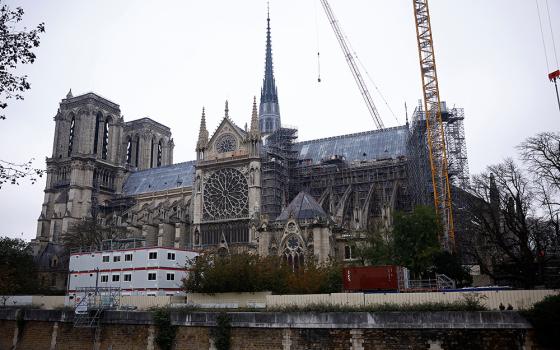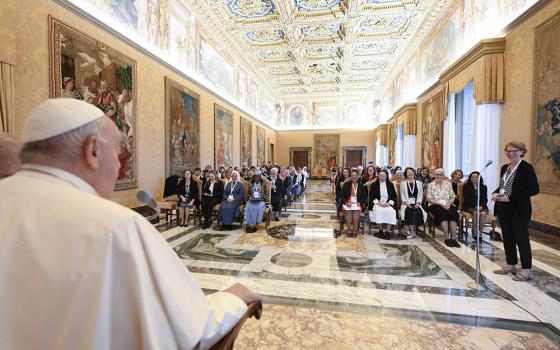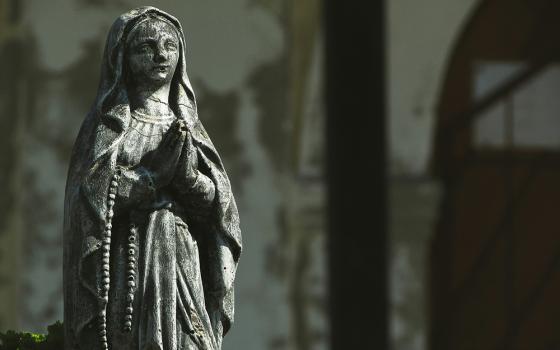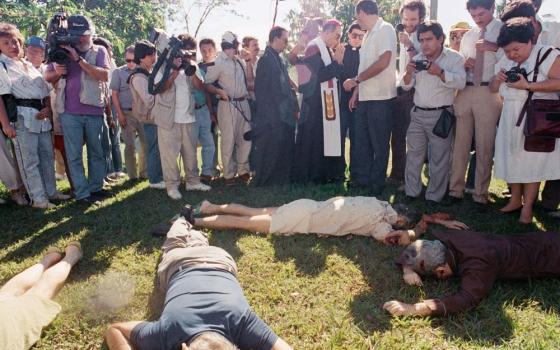
Retired Bishop John M. Smith of Trenton, N.J., died Jan. 22 at age 83 in Morris Hall Meadows, an assisted living community Lawrenceville, N.J. He is pictured in an undated photo. (CNS photo/Craig Pittelli, courtesy Diocese of Trenton)
Retired Bishop John M. Smith of Trenton died Jan. 22 in Morris Hall Meadows, a long-term care facility in Lawrenceville, after a long illness. He was 83.
Bishop David M. O'Connell, who succeeded Bishop Smith as head of the diocese in 2010, told the diocese in a statement it was his "sad duty" to announce the death of his predecessor.
St. Mary of the Assumption Cathedral in Trenton will receive the late bishop's body the afternoon of Jan. 25. His body will lie in repose until the celebration of the Mass of Jesus Christ the High Priest that evening.
A funeral Mass will be celebrated Jan. 26. Afterward, Bishop Smith will be entombed in the mausoleum of St. Mary Cemetery in Trenton.
Bishop Smith, a New Jersey native, headed the Trenton Diocese from 1997 to 2010. Before that, he was coadjutor bishop from two years and then he succeeded his predecessor, Bishop John C. Reiss, when he retired.
Before returning to his home state as a bishop, Bishop Smith head the Diocese of Pensacola-Tallahassee, Florida, from 1991 to 1995 and before that, he was an auxiliary bishop of the Archdiocese of Newark for three years. Newark was his home archdiocese; he was ordained a priest there May 27, 1961.
Born June 23, 1935, in Orange, to Mortimer and Ethel Smith, both now deceased, John Mortimer Fourette Smith was the oldest of three children. He had two brothers, Benedictine Father Andrew Smith and Gregory Smith.He is survived by his brothers.
He attended St. Benedict’s Preparatory School in Newark and Jesuit-run John Carroll University in Cleveland. He entered Immaculate Conception Seminary at Seton Hall University in South Orange in 1955.
After his 1961 ordination, then-Father Smith held several position in the Archdiocese of Newark, among them assistant chancellor, tribunal official, parish priest, director of the Cursillo movement and dean of the archdiocese's Bergen County deanery.
In 1966, he earned a doctorate in canon law from The Catholic University of America in Washington. In 1971, Father Smith was named a monsignor by St. Paul VI.
In 1982, Msgr. Smith was appointed to the faculty of the Pontifical North American College in Rome where he served until his return to Newark in 1986. He was appointed pastor of St. Mary Parish in Dumont, and, was the archdiocese’s vicar general and moderator of the curia.
In an interview Bishop Smith gave Catholic News Service about a month after 9/11, he spoke of the impact the terrorist attack had on the people of New Jersey. Dozens of parishes had parishioners who died in the World Trade Center collapse.
The Trenton Diocese alone is home to more than 774,000 Catholics in a 2,100-square-mile area -- with a Catholic church in nearly every town.
New Jersey is where tens of thousands of people who work in New York City have chosen to raise their families. Most make the roughly one-hour commute to their jobs by train or ferry in exchange for living in neighborhoods that border farms, woods, soccer fields or the shore.
Advertisement
And although these havens from the city were rocked by the tragedy, the parishes seem to be coming out intact, strengthened by putting their faith into action, he said in that interview.
"I'm so impressed by the level of faith and real bravery'' people have shown, Bishop Smith told CNS at the time. "Wives who lost their husbands and mothers who lost their sons have a sense of living their faith in difficult times.''
In times like that, he added, people have come to realize that "faith is the bedrock of our lives even if the importance of faith has been eclipsed when things were going well.''
But he didn't expect Catholics not be angry about what happened or for church leaders to somehow come up with an explanation for the atrocities.
"The best thing is to be present. If people need to punch a wall, let them. If they are angry at God, let them. The most difficult thing is when some use cliches to take away grief," he said. Those who have suffered, "have a right to their grief and their anger,'' he added.
Many of the priests of the diocese were on the front lines ministering to those who have lost loved ones, and for that "I've never been prouder of being a bishop.''
The weekend after the attacks, Bishop Smith went to four parishes in the diocese that had been particularly hard hit by the World Trade Center collapse. He later visited ground zero, the site of the collapsed skyscrapers.
Amid the firefighters, police officers and rescue workers, the bishop thought, "As a cleric, what purpose do I have here?''
But he soon found out. Workers told him they were glad he was there and many asked for prayers.
Then, as he put it, "a great big ironworker said, 'I want you to see God's house.''' He brought the bishop over to a section of a collapsed building and pointed out two metal beams that remained intact in the form of a cross. "That's Jesus' presence in hell,'' the man told him.
That cross of iron became an iconic symbol of the tragedy and was eventually taken to National September 11 Memorial and Museum, completed some three years later.
Bishop Smith urged people not to forget the dedication of the firefighters and law enforcement officers, comparing them to "martyrs of the early church, giving witness with their lives.''







